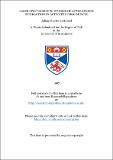Files in this item
Laser spectroscopic studies of actin-myosin interaction in activated frog muscle
Item metadata
| dc.contributor.advisor | Flitney, F. W. | |
| dc.contributor.author | Eastwood, Julian Charles | |
| dc.coverage.spatial | 200 p. | en_US |
| dc.date.accessioned | 2018-07-02T08:37:23Z | |
| dc.date.available | 2018-07-02T08:37:23Z | |
| dc.date.issued | 1987 | |
| dc.identifier.uri | https://hdl.handle.net/10023/14769 | |
| dc.description.abstract | Frog sartorius muscles were illuminated with laser light (λ = 457.9 - 632.8nm), stimulated electrically and stretched at the plateau of an isometric tetanus. An electro-optic system was used to rapidly (~7kHz) switch the electric vector of the incident beam through π/2 radians (between ϕ = 0° and 90°, relative to the muscle long axis) and 'simultaneous' recordings of transmitted light intensity (Ia) were made at orthogonal beam orientations during single contractions, using a sample-hold device. Stretch causes Ia to fall: this is represented either as a decrease of transparency or an increase of turbidity (τ). The amplitudes of the optical transients vary in direct proportion to the tension increment generated by stretch (which is related to the extent of actin-myosin filament overlap) and are highly anisotropic with respect to both λ and ϕ. At any given λ the amplitude for ϕ = 0° > ϕ - 90°. Both 0° and 90° signals vary inversely with λ: the wavelength exponent for the former is -2.39 and for the latter, -3.87. An attempt is made to analyse the changes in conservative dichroism (= Δτ0° - Δτ90°) using a model in which the scattering elements are forced to undergo a change of angular orientation (Δγ). The size of the scattering particles is estimated to be ~17nm (long axis) and to occupy ~0.038 of the fibre volume. It is postulated that the dichroic signal is due to a change in cross-bridge head (= S-1 HMM) orientation. The linear dimension of the actin-myosin interactive surface is estimated (from Δγ) to be >4.8nm. The results are interpreted in terms of a multi-step force generating cycle, based on the Huxley-Simmons model in which each head progresses through as many as 5 to 7 discrete positions during its working stroke, each separated from its neighbour by a potential difference energy of ~0.46x10-20J. | en_US |
| dc.language.iso | en | en_US |
| dc.publisher | University of St Andrews | |
| dc.subject.lcc | QP369.L2E2 | |
| dc.subject.lcsh | Muscle receptors | en |
| dc.title | Laser spectroscopic studies of actin-myosin interaction in activated frog muscle | en_US |
| dc.type | Thesis | en_US |
| dc.contributor.sponsor | Biotechnology and Biological Sciences Research Council (BBSRC) | en_US |
| dc.contributor.sponsor | Wellcome Trust | en_US |
| dc.contributor.sponsor | Medical Research Council (MRC) | en_US |
| dc.type.qualificationlevel | Doctoral | en_US |
| dc.type.qualificationname | PhD Doctor of Philosophy | en_US |
| dc.publisher.institution | The University of St Andrews | en_US |
This item appears in the following Collection(s)
Items in the St Andrews Research Repository are protected by copyright, with all rights reserved, unless otherwise indicated.

